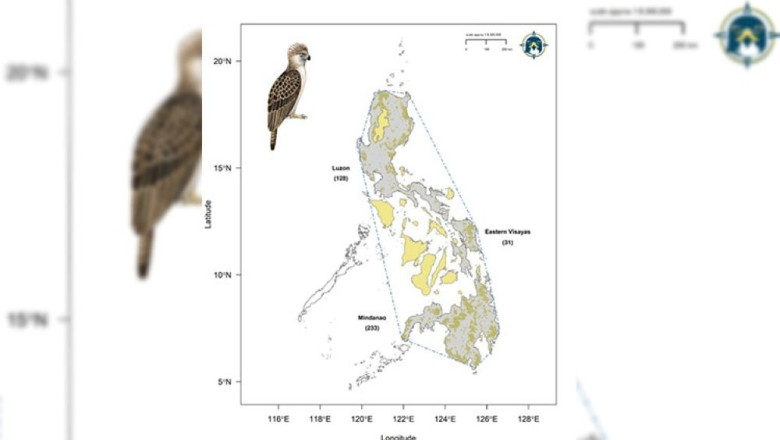
An equally unique apex predator serves an important ecological role at the top of the country's exceptional ecological pyramid. While most of the world's top carnivores are mammals, such as the iconic African Lions and Sumatran Tigers, the top carnivore in the Philippines is a forest eagle. The great and mighty Philippine Eagle is this "Bird of Prey" (Pithecophaga jefferyi).
Territorial pairs of Philippine Eagles, found only on the country's four major islands (Luzon, Leyte, Samar, and Mindanao), have long served as "ecological keystones" in the Philippine Forest ecosystem.
But, as powerful as it is, the Philippine national symbol's survival is in jeopardy. Since 1996, the International Union for Conservation of Nature (IUCN) has listed it as "Critically Endangered," but deforestation of its valuable habitat and human persecution through shooting and trapping continue to threaten its survival. The serious lack of scientific information required for decision-making limits the effectiveness of conservation efforts as well.
“Despite being one of the most endangered forest eagles in the world, we still lack fundamental information regarding Philippine Eagle distribution and population size,” said Dennis Salvador, Executive Director of the Philippine Eagle Foundation and co-author of the paper “Priority conservation areas and a global population estimate for the critically endangered Philippine Eagle” published in the journal “Animal Conservation”.
“This is very upsetting considering that the world might lose this majestic eagle within this lifetime if we don’t act fast to save it,” Salvador said.
“Understanding how species are distributed and a reliable estimate of population size are key biological parameters for any threatened species,” said Luke Sutton, Post-Doctoral Research Fellow at The Peregrine Fund in Boise, Idaho, USA, and lead author of the paper.
The paper was divided into two sections. The first section included two key components: I an updated method for estimating IUCN range metrics, and (ii) population size estimation based on modeling highly suitable eagle habitat and the most recent average area requirement of one territorial eagle pair measured using "state-of-the-art" satellite telemetry techniques.
Priority eagle habitats on Mindanao that require immediate protection include: I Mt Hilong-hilong, (ii) Mt Kampalili-Puting Bato, (iii) Mt Latian complex, and (iv) Mt Busa-Kiamba. Protected areas in the Mt Piagayungan and Butig Mountains, as well as the Munai/Tambo Key Biodiversity Areas in east-central Mindanao, could also be expanded. The Mts. are a priority for protection in northern-central Mindanao. The Kaluayan-Kinabalian Complex (or the Pantaron Ranges) includes Mt. Balatukan and the Mt. Tago Range.
The Anonang-Lobi Range in Leyte Province and Mt. Nacolod in Southern Leyte are the priority eagle habitats on Leyte Island. Both are excellent eagle habitats, but recent expeditions indicate that eagles may have been lost there already. These habitats could be used for eagle reintroductions in the future.
“The information and insights contained in the paper have substantially improved our knowledge and understanding of the status and conservation needs of the Philippine Eagle in the wild,” said Jayson Ibanez, Director of Research and Conservation at the Philippine Eagle Foundation and also a co-author of the new publication.
“With the accurate population baselines that we now have, and the fact that the species remains heavily persecuted in the wild, we can re-program and prioritize our actions, by (i) finding as many of these 392 territorial nesting pairs across the country as possible through systematic nest surveys, (ii) protect as many of the threatened eagle nest sites through improved education outreach, wildlife law enforcement and community-based conservation, and (iii) ensure the reproductive success and survival of each adult pair and each of the young they hatch through telemetry and field monitoring,” said Dr. Ibanez.
“We are thrilled to analyze decades worth of the hard-earned field data collected by our colleagues at the Philippine Eagle Foundation” says Chris McClure, Executive Vice President of Science and Conservation at The Peregrine Fund and co-author of the paper. The Philippine Eagle Foundation is an active member of the Global Raptor Impact Network - a network and database for studying and conserving the world’s raptors that is convened by The Peregrine Fund.
“The scientific and grassroots approach of the Philippine Eagle Foundation and its network of government, private sector and community collaborators is an ideal model for national raptor conservation,” Dr. McClure added.
In addition to the individuals mentioned above, the Philippine Eagle Foundation's Biologist Rowell Taraya and Tristan Senarillos, as well as GIS Specialist Guiller Opiso, contributed to this study.





















Facebook Conversations